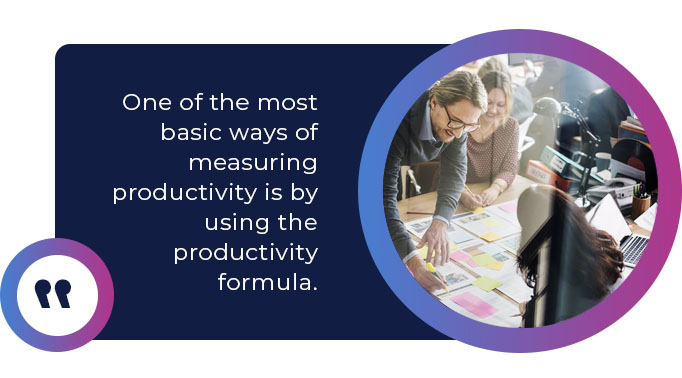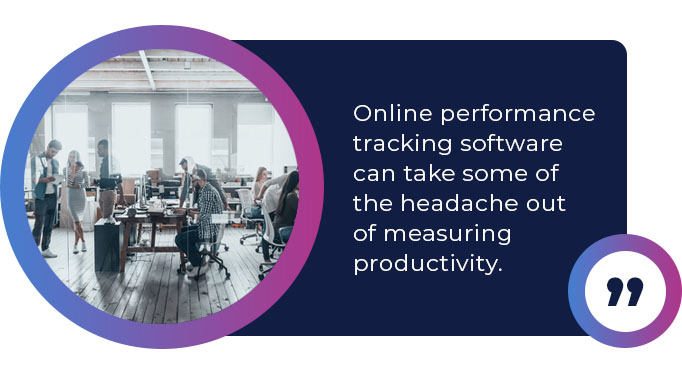It’s no secret that our society is obsessed with productivity. Employees want to find ways to do more in less time to accelerate their careers. Business leaders want to maximize their efficiency to increase their revenues. Government officials want to improve outputs to drive economic growth and prosperity.
The real challenge is figuring out how to measure productivity in a meaningful way. How do you measure something as intangible as productivity?
In this post, we’ll break down a few common techniques for measuring productivity in the workplace.
Related: Skills Gap Analysis
The Productivity Formula
One of the most basic ways of measuring productivity is by using the productivity formula. This formula calculates the quantity of output per unit of input over a specific period of time. Outputs include revenue or units of finished goods, while inputs include things such as raw materials, labor, or capital assets.

Output/Input = Workforce Productivity
As an example, let’s say your company generated $60,000 worth of goods in 1,400 hours. To calculate the labor productivity: $60,000/1,400 hours = $43 per hour of work.
You can use this formula to measure the productivity of a department or organization and get actual numbers. It works particularly well in organizations and departments where each unit produced is of equal value.
The 360 Degree Feedback Strategy
While hard numbers can be useful for measuring productivity, they rarely tell the entire story. Employers need human feedback from their employees to fill in the gaps, and that’s where the 360 Degree Feedback strategy can help.
With this strategy, employers ask their employees to provide confidential, anonymous feedback regarding the productivity of their fellow employees. This gives you a more complete picture of who is doing the work and meeting their goals.
The 360 Degree Feedback strategy is far from perfect. However, it is particularly ideal for a small organization or a close-knit team of employees. For it to be successful, every employee on the team must have a good understanding of various roles within the company.
Online Performance Tracking
You may already use digital tools and workforce development software to optimize productivity in the workplace. But do you use digital tools to measure productivity?

Online performance tracking software can take some of the headache out of measuring productivity by allowing employers to track relevant data automatically. For instance, many online performance tracking systems use electronic treats to track time spent on projects and specific tasks. This data can then be easily generated into performance reports.
While online performance tracking software can be incredibly useful for organizations, they don’t provide the complete picture of an employee’s productivity. Therefore, it’s important to use additional techniques to measure productivity.
Projects Completed
Another way to measure productivity is by tracking project completion and accomplishments rather than minutes and hours. In other words, is the work getting done?
This strategy is particularly common in the startup world, where founders and their employees often have important deadlines they need to meet. Employees are assigned a task or project and have their own key performance indicators (KPIs) to evaluate their success.
One downside to tracking projects completed is that it can potentially lead to employee burnout, which will ultimately hurt an organization’s productivity. When tracking this metric, it’s important for employers to emphasize flexibility and healthy work-life balance.
Profits Generated
Profit is essential to a company’s survival. And given that higher productivity is strongly associated with higher profits, it makes perfect sense for employers to use profit as a means of measuring productivity.
This method is generally preferred by smaller organizations because it’s simple and doable. Additionally, it helps ensure that employees aren’t unfairly punished for taking longer on a project in order to produce the best possible product for clients.
Daily Check-Ins
While some business owners rely on profits to measure productivity, others prefer to measure how well their employees stay on-task. Less focus is placed on output and profit. Instead, employers have daily check-ins with the team to ensure that everyone is reaching their targets.
There are several ways you can hold check-ins with your employees, the most common being conference calls and meetings. You can also hold check-ins by way of email, Google Hangouts, or a dedicated Slack channel.
Measuring Leads to Growth
To paraphrase Peter Drucker, you can’t manage what you don’t measure. By collecting valuable data through workforce development software and other digital tools, you can uncover actionable insights that spur economic growth and competitiveness. But more than that, they can help your employees reach their individual goals and feel more fulfilled at work.
LET TALLO POWER YOUR WORKFORCE INITIATIVE
Image Credits
Source: Rawpixel.com/Shutterstock
Source: G-Stock Studio/Shutterstock
Source: Flamingo Images/Shutterstock




